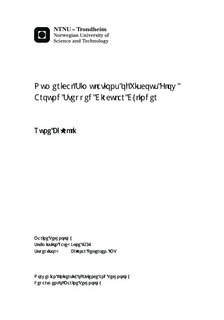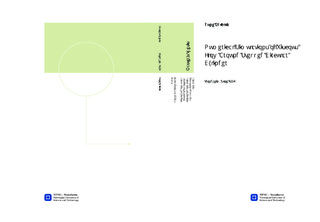| dc.description.abstract | A stepped cylinder could be a desired design for an offshore buoy or SPAR platform. The geometry of a stepped cylinder consists of a small diameter cylinder (d) placed on top of a large diameter cylinder (D). This master thesis has investigated numerically the flow around a stepped cylinder with different diameter ratios (d/D) for a Reynolds number, ReD = 150. The commercial software Fluent v13.0 by Ansys was used for the numerical investigation.The aim of the study has been exploring the nearby wake flow as well as the region where the two cylinders are joined. The hydrodynamic forces and vortex shedding frequency have been analysed and compared for the four different diameter ratios: d/D = 0.3, 0.5, 0.8 and 0.9The major part of the published papers on the topic is based on experimental studies. Only two papers are based on numerical studies, having considered d/D = 0.5 exclusively. Earlier studies have focused mainly on vortex shedding in the wake flow, omitting the forces acting on the stepped cylinder.The stepped cylinder has been modelled using the software GAMBIT. A convergence study investigating the domain size and element density was conducted to ensure a grid independent solution. Special attention was directed at the step region to fully resolve the complex flow in this region. The numerical model was verified to be in good agreement with previous experimental- and numerical studies.For the stepped cylinders significant spanwise velocity was detected in the step region. For d/D = 0.3 and 0.5, upflow was detected over the leading edge of the step whereas downwash characterised the trailing edge of the step. Similarities to the flow around a finite length cylinder could be drawn for d/D = 0.3 and 0.5, whereas d/D = 0.8 and 0.9 resembled that of a straight cylinder.The step was found to affect the wake flow ≈ 10D into D independent of diameter ratio. The wake flow behind the small diameter cylinder was less affected by the step than the large for d/D < 0.5. In the step region two distinct streamwise vortices were detected. A pair of edge vortices as well as a junction vortex were readily detected for d/D = 0.3 and 0.5. The junction vortex was not detected for d/D = 0.8 and 0.9 due to the small step change in diameter.The drag force on D was found to increase as d/D increased. Similarly, the amplitude of the lift force was also found to increase as d/D increased. The mean drag-coefficient varied along the span with peaks in the local drag-coefficient observed in close vicinity of the step.Regular spanwise vortex shedding was detected away from the step at a frequency similar to that of a straight cylinder. In the step region, located mainly on D, a cell of lower vortex shedding frequency was detected for d/D = 0.3 and 0.5. As d/D increased this cell seemed to disappear. Suppression of regular vortex shedding close to the step for d/D = 0.3 was observed for ReD = 150, 300 and 600. For ReD > 150 the large spanwise vortex structures were still discernible, but the presence of small-scale streamwise vortices complicated the flow. | nb_NO |

